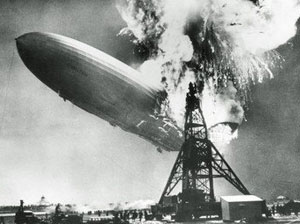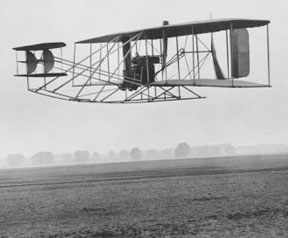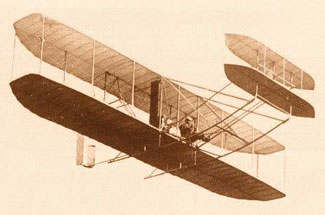Powered Flight
The origins of flight

Man's passion to fly must have originated in prehistoric times. The beauty and freedom of soaring birds has always drawn our admiration and envy. The freedom to move in any direction over all obstacles is a capability that all of us would enjoy.
Early attempts to defy gravity involved the invention of ingenuous machines, such as ornithopters. This type of flying machine utilizes the flapping of the wings in order to achieve flight. Needless to say that all attempts to fly using this type of machine failed.
Balloon flight

The idea of filling a closed container with a substance that normally rises through the atmosphere originated in the thirteenth century. Over a five hundred year span, different substances came to be known as being lighter-than-air. The most common gases proposed were water vapor, helium and hydrogen.
The first successful attempts at achieving flight using this type of craft were made by the Montgolfier brothers in France. Their most successful attempt was in 1783 when in a public demonstration, they achieved 1,828 m (6,000 ft) in a balloon with a diameter of more than 30 m (100 ft).
In 1937 the large Hindenburg was successful until it was destroyed by fire while attempting a landing in Lakehurst, New Jersey. Nowadays, the blimp has become ubiquitous, appearing over the skies of ballgames and large outdoor events.
Gliders

In the early 1900s two American brothers, Orville and Wilbur Wright from Dayton, Ohio began to experiment with gliders. The gliders were built using the results of experiments conducted by Otto Lilienthal in Europe. Most of these flights turned out to be a failure.
In 1901, they gathered their own wing data by conducting systematic experiments on different types of wing configurations, from which came the 1902 Glider, a machine with a tip-to-tip wing measurement of 9 m (32 ft) and wing width of 1 m (5 ft). The aircraft could go up or down, left or right, and could also roll about its longitudinal axis. The problem of aircraft control and stability had been conquered.
Powered aircrafts

The Wright brothers were confident about their ability to fly and decided to turn their attention to power. Unable to find an engine manufacturer to meet their specifications of 8 horsepower and engine weight of less than 200 pounds, they decided to design and build their own engine.
Aided by their bicycle mechanic Charlie Taylor, they were able to build an engine that produced 12 horsepower. They were able to build accurately the engine propellers, and in 1903, after redesigning the airframe of their 1902 Glider, the Kitty Hawk Flyer was born. With this aircraft, in December 17, 1903, Orville and Wilbur Wright demonstrated the flight of self powered aircraft. Human beings had finally really flown.
Modern flight

As time went by, the speed of airplanes began to increase. From the famous 12 mph top-speed of the Wright Brothers Kitty Hawk Flyer to the 400+ mph of the famous Army Air Force (later USAF) fighter P-51 Mustang, used in World War II.
Even though the velocity of newer aircraft was increasing, very soon it was realized that an invisible 'barrier' was preventing aircraft from surpassing the speed of sound. This barrier was known as the famous "sound barrier". The barrier took the life of several test pilots as they attempted to break the "sound barrier" in the famous experimental aircraft, such as Bell X-1. In 1947, a young test pilot named Chuck Yeager broke that barrier and exceeded the speed of sound. From that point on a series of experimental supersonic aircraft took to the sky breaking speed record after speed record.
Today we still can see some of the supersonic aircraft that were built in the 1960's; for example - The British Concord (cruise speed: Mach 2.0), the Russian TU-144 (cruise speed: Mach 2.2), and the famous American spy plane SR-71 Blackbird (cruise speed: classified but known to be over Mach 3.0).